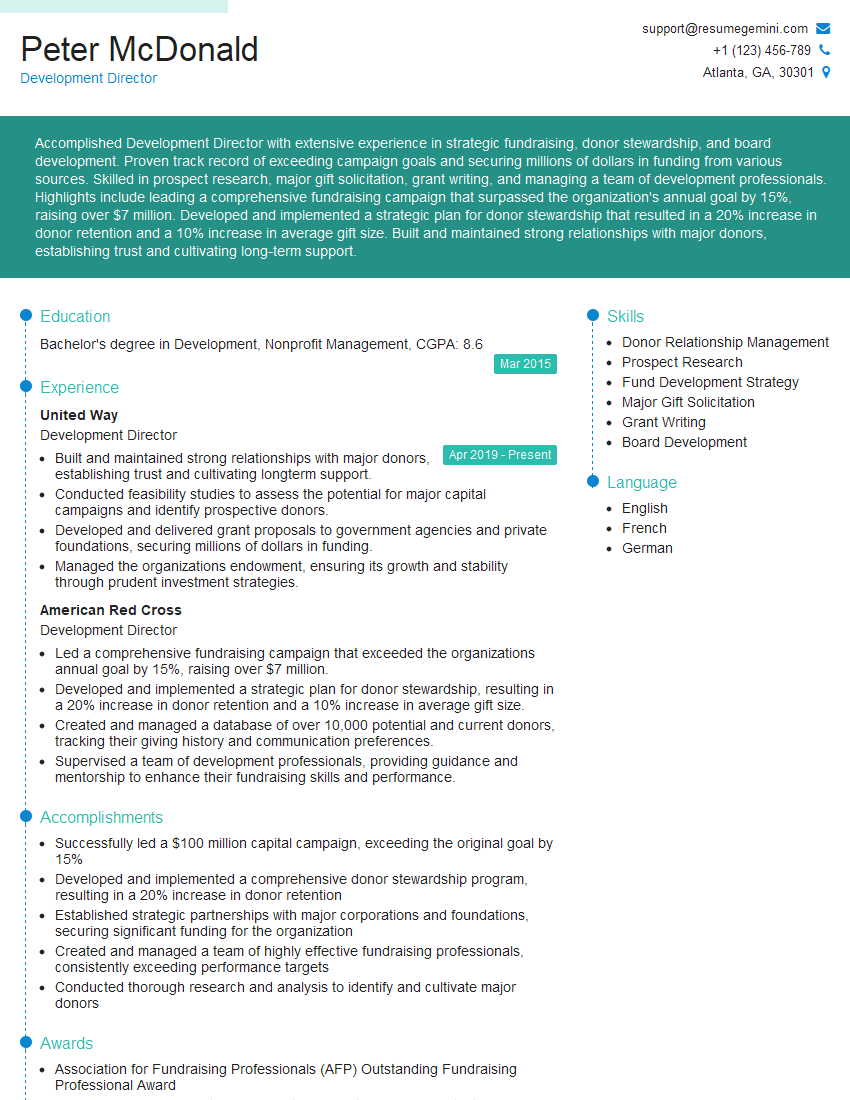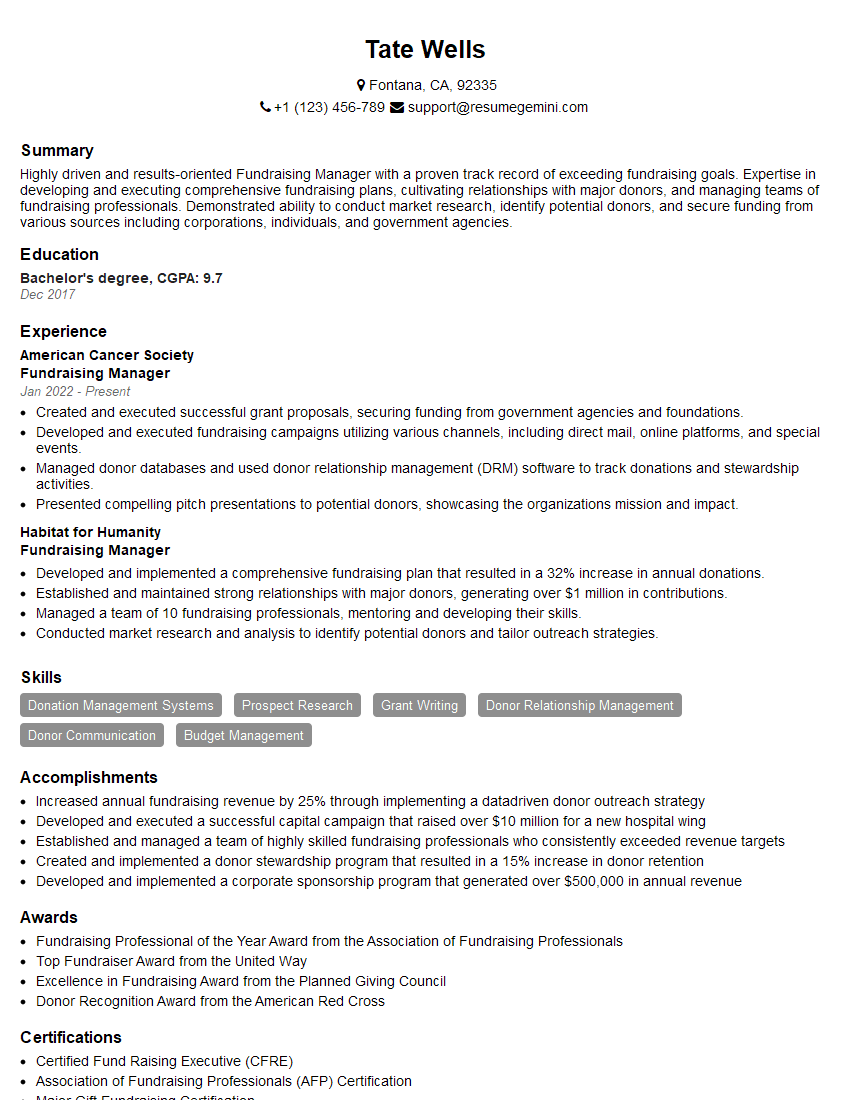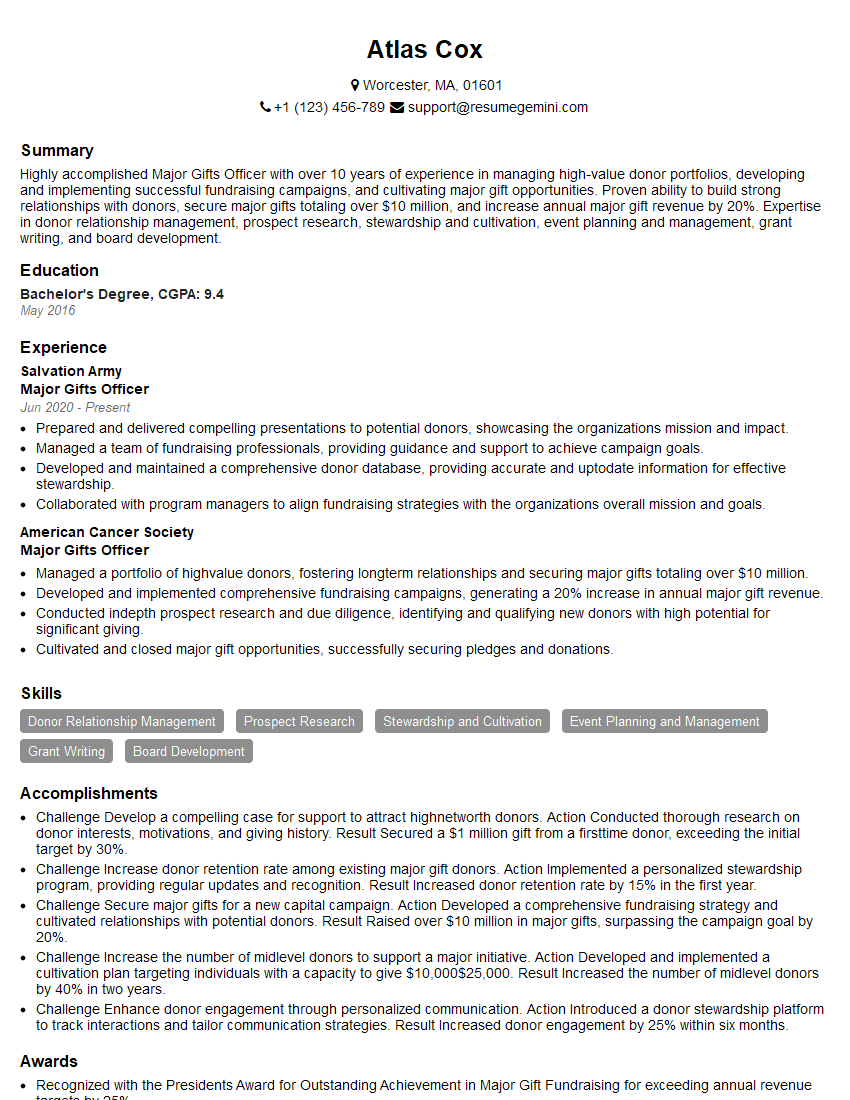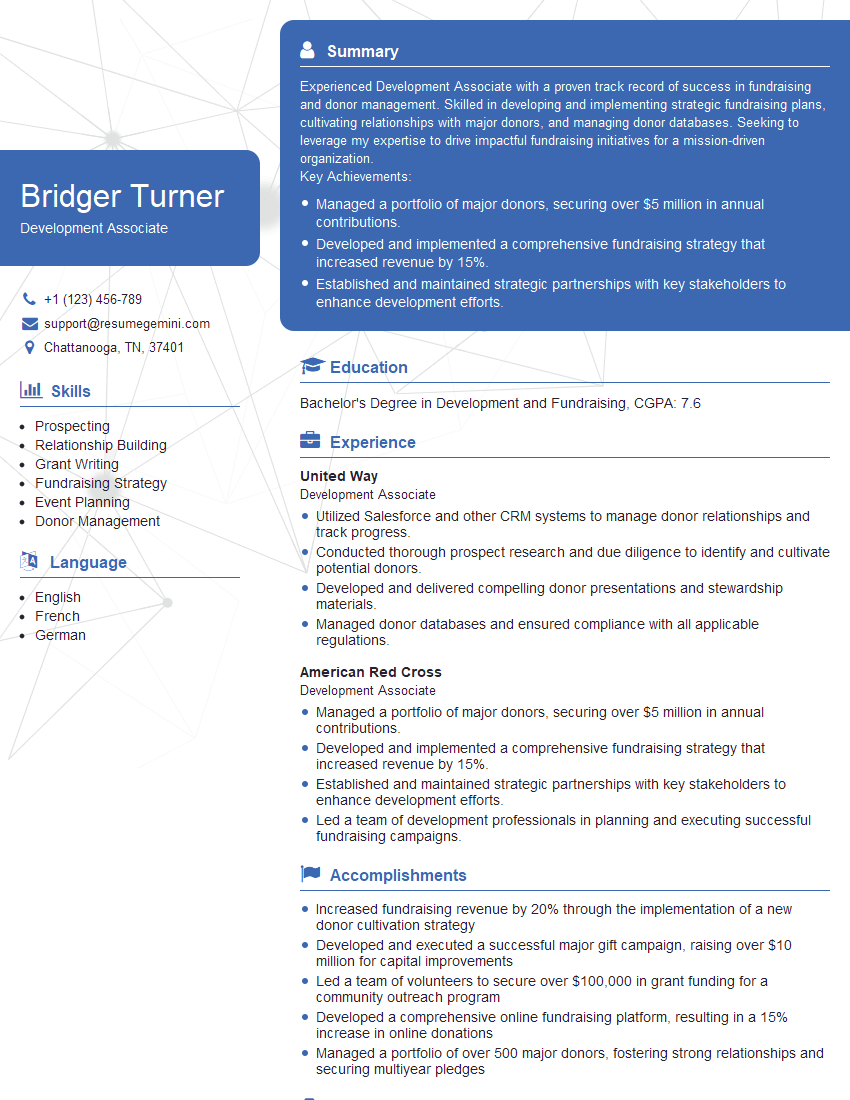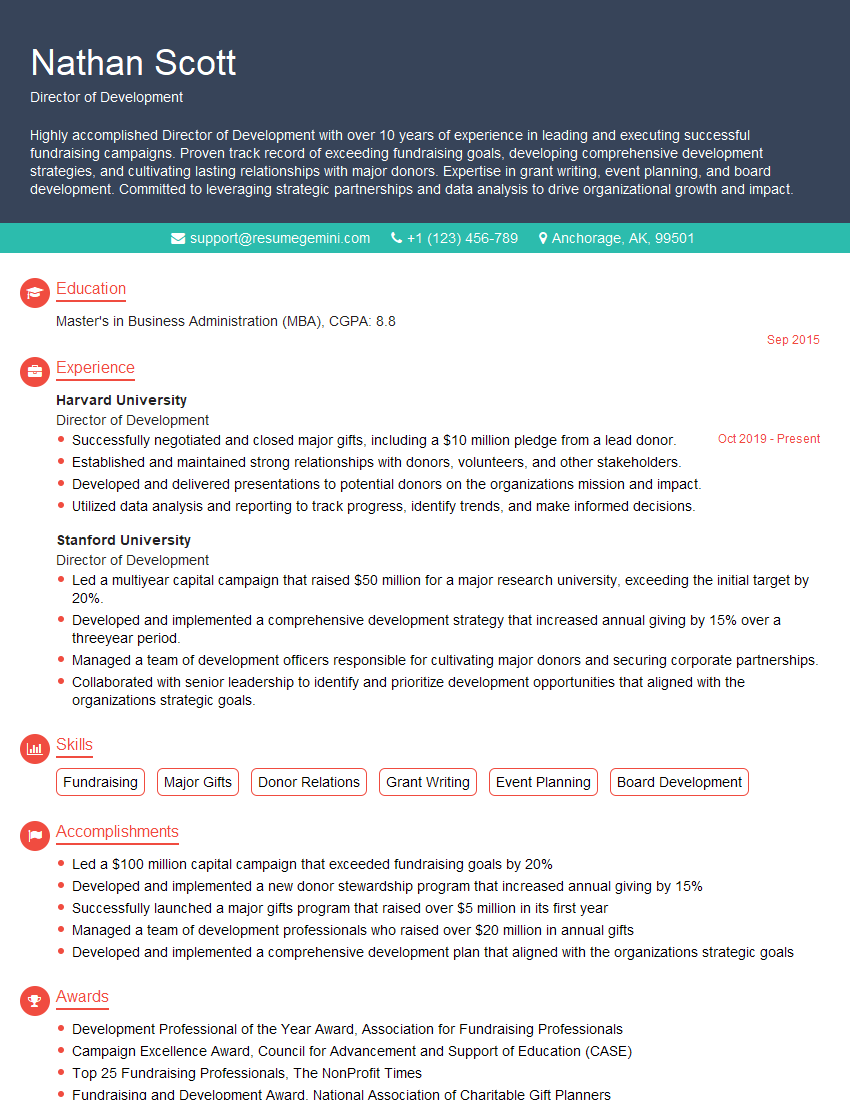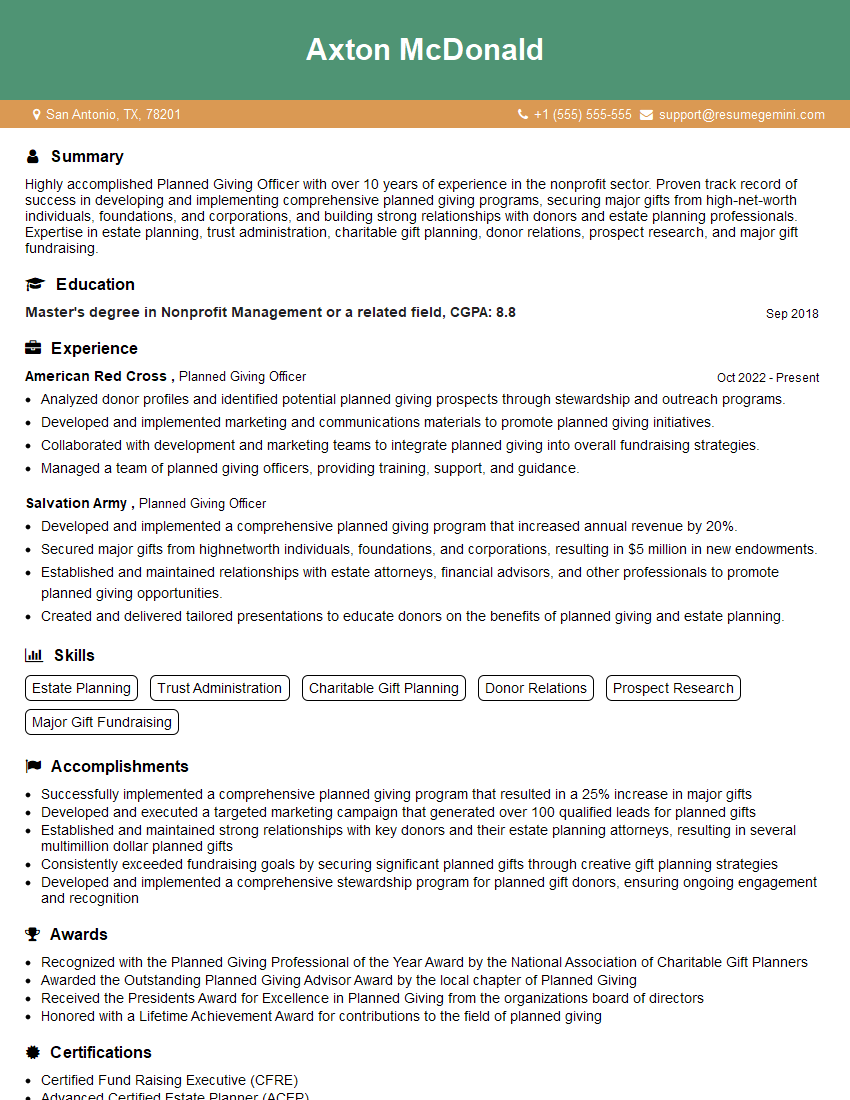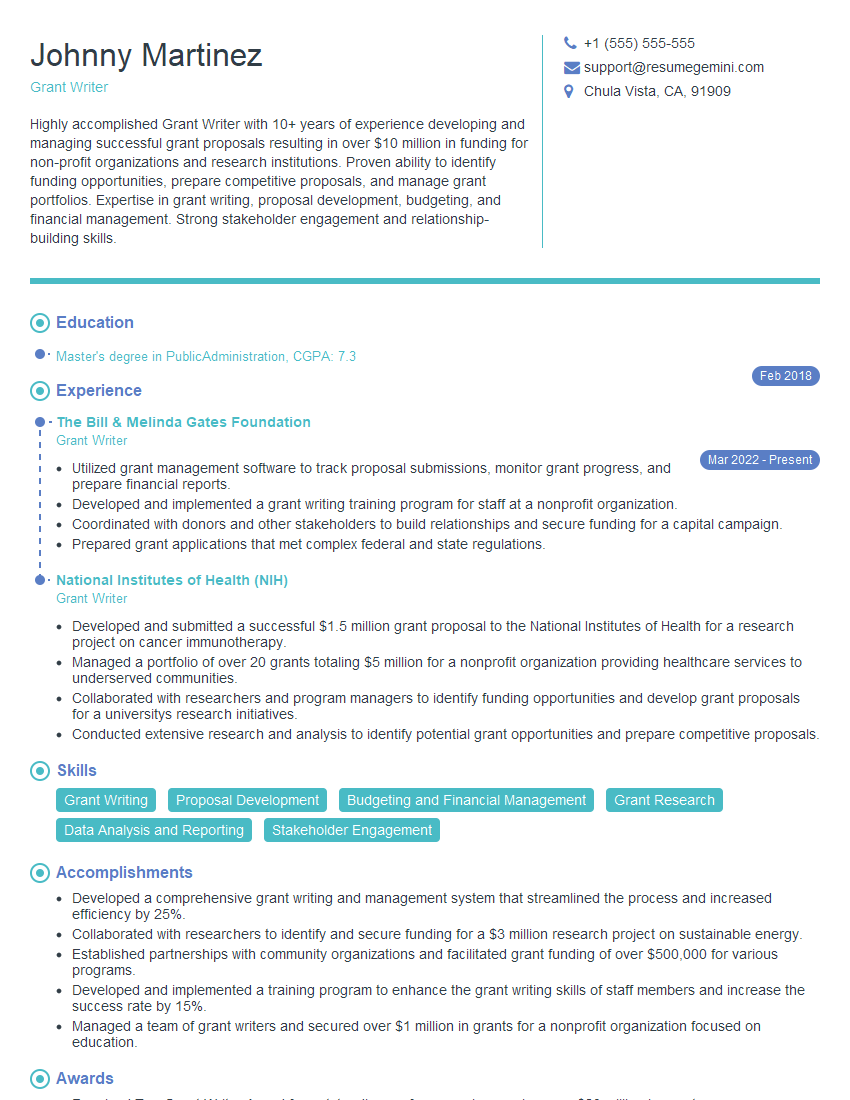Every successful interview starts with knowing what to expect. In this blog, we’ll take you through the top Art Fundraising interview questions, breaking them down with expert tips to help you deliver impactful answers. Step into your next interview fully prepared and ready to succeed.
Questions Asked in Art Fundraising Interview
Q 1. Describe your experience in securing major gifts for arts organizations.
Securing major gifts for arts organizations requires a blend of strategic planning, relationship building, and persuasive communication. My experience involves identifying potential donors with a demonstrated passion for the arts and a capacity for significant giving. This often includes researching their philanthropic history, understanding their giving priorities, and crafting a compelling case for support tailored specifically to their interests. For example, I successfully secured a $2 million donation from a private collector for a museum expansion by showcasing how the new wing would allow for better display and preservation of their specific area of interest – Impressionist paintings. The process included several meetings, highlighting the museum’s vision and the impact of their contribution, culminating in a formal proposal and a signed pledge.
Another successful campaign involved securing a multi-year pledge from a foundation for a new educational program. Here, a detailed budget, program evaluation plan, and clear articulation of the program’s community impact were crucial in securing the funding.
Q 2. What strategies have you used to cultivate relationships with high-net-worth donors?
Cultivating relationships with high-net-worth donors is a long-term investment. It’s not about asking for money immediately, but about building trust and understanding their philanthropic motivations. My approach involves personalized communication—invitations to exclusive events, museum previews, or artist meet-and-greets. I also focus on demonstrating the organization’s impact through regular updates, progress reports, and invitations to participate in key events.
For example, I organized a private dinner for a group of potential donors with the museum’s director and a renowned artist. This intimate setting allowed for genuine connections and fostered a deeper understanding of the organization’s mission. Furthermore, I maintain consistent communication, even when not directly soliciting donations, sending relevant articles, exhibition announcements, or simply checking in on their well-being. This consistent engagement helps build strong, long-lasting relationships.
Q 3. How do you identify and prioritize potential funding sources for an art institution?
Identifying and prioritizing funding sources requires a thorough understanding of the art institution’s needs and a systematic approach to research. This involves compiling a list of potential funders, including foundations, corporations, government agencies, and individual donors. I begin by analyzing their grant guidelines, past giving patterns, and areas of interest. Then, I prioritize potential sources based on alignment with the institution’s mission, project scope, and the funder’s giving priorities.
For instance, when seeking funding for a new digital art installation, I would prioritize foundations focused on technology and innovation, as well as corporations with a history of supporting contemporary art. A ranking system, based on factors like past giving, alignment with project goals, and likelihood of securing funding, is essential to effectively manage the process. This ensures that the institution’s time and resources are focused on the most promising prospects.
Q 4. Explain your experience with grant writing and proposal development for arts projects.
Grant writing and proposal development are crucial for securing external funding. My experience encompasses crafting compelling narratives that highlight project goals, impact, and budget justification. I am proficient in researching and adapting proposals to align with each funder’s specific requirements and guidelines. Each proposal undergoes multiple revisions and internal reviews to ensure clarity, accuracy, and persuasiveness.
For instance, a successful grant proposal for a community art education program involved detailed descriptions of the program’s curriculum, its anticipated impact on the community, and a robust evaluation plan. Use of strong visuals, data demonstrating need, and testimonials from beneficiaries greatly enhanced the impact and credibility of the proposal.
Q 5. How familiar are you with different fundraising models (e.g., annual giving, capital campaigns)?
I have extensive familiarity with various fundraising models, including annual giving, capital campaigns, major gifts, planned giving, and endowment building.
Annual giving focuses on cultivating recurring donations from a broad base of supporters, often through email campaigns, membership drives, and direct mail appeals. Capital campaigns are large-scale fundraising efforts focused on a specific goal, such as building a new facility or acquiring a major artwork. Major gifts involve cultivating relationships with high-net-worth individuals to secure significant donations. Planned giving encourages donors to include the organization in their estate plans, ensuring long-term financial sustainability. Endowment building involves establishing a fund that generates income to support the organization’s ongoing operations.
Understanding the strengths and weaknesses of each model is crucial in developing a comprehensive fundraising strategy that aligns with the organization’s goals and resources. Choosing the right model often depends on the organization’s size, stage of development, and specific fundraising objectives.
Q 6. What metrics do you use to track the success of fundraising campaigns?
Tracking the success of fundraising campaigns requires a robust system of metrics. Key metrics I use include:
- Total dollars raised: The overall amount of money raised during the campaign.
- Number of donors: The total number of individuals or organizations who contributed.
- Average gift size: The average amount of each donation.
- Donor retention rate: The percentage of donors who contributed in the previous year and continue to donate.
- Cost per dollar raised: The amount spent on fundraising activities relative to the funds raised.
- Conversion rate: The percentage of prospects who made a donation after being solicited.
Analyzing these metrics provides insights into campaign effectiveness and helps inform future fundraising strategies. For example, a low conversion rate might suggest a need to refine messaging or targeting strategies, while a high cost per dollar raised may indicate the need to streamline fundraising operations.
Q 7. Describe your experience managing a fundraising database and reporting on donor activity.
I have extensive experience managing fundraising databases (like Raiser’s Edge or DonorPerfect) and generating reports on donor activity. This includes data entry, data cleaning, segmentation of donor lists, and creating customized reports to track giving trends, donor engagement, and campaign progress. I use these reports to identify high-potential donors, tailor communication strategies, and measure the overall effectiveness of fundraising efforts.
For example, I might generate a report showing the giving history of all donors who have contributed over $10,000 in the past five years. This allows me to identify top donors and develop targeted cultivation strategies to increase their giving. Another common report would segment donors by giving level, allowing for the tailoring of communication and cultivation efforts for different donor segments.
Q 8. How do you build and maintain relationships with corporate and foundation sponsors?
Building and maintaining strong relationships with corporate and foundation sponsors is crucial for sustainable art fundraising. It’s not just about securing a single donation; it’s about cultivating long-term partnerships.
- Proactive Outreach: I begin by identifying potential sponsors whose values align with the art organization’s mission. This might involve researching companies known for their philanthropic activities or foundations focused on the arts.
- Personalized Communication: Generic emails won’t cut it. I craft personalized proposals highlighting the specific benefits of sponsorship, such as brand alignment, community engagement opportunities, and exclusive access to events. I emphasize the unique aspects of each project and tailor the communication to the sponsor’s interests.
- Relationship Cultivation: Following up is key. I stay in regular contact, providing updates on project progress, sharing impactful stories, and inviting sponsors to relevant events. I aim to build genuine rapport, fostering a feeling of mutual respect and shared purpose.
- Transparency and Reporting: Providing regular, transparent reports on the impact of their contribution is essential. This demonstrates accountability and builds trust, which is fundamental for long-term relationships. This includes showing how the funds were used and highlighting the successes achieved.
- Exclusive Benefits: Offering exclusive benefits, such as naming rights, logo placement, or invitations to VIP events, incentivizes sponsors and enhances their engagement.
For example, I once secured a multi-year sponsorship from a local bank by demonstrating how sponsoring our annual art exhibition would align with their community investment goals and offer valuable brand visibility.
Q 9. What is your experience with event planning and execution for fundraising purposes?
Event planning and execution are central to my fundraising strategy. Successful events go beyond just raising money; they create memorable experiences that foster community engagement and build support for the arts.
- Strategic Planning: I start by defining clear goals and objectives for the event, including the target fundraising amount and the type of audience we want to reach. This includes identifying potential attendees, establishing a budget, and selecting a suitable venue.
- Logistics and Execution: This phase involves securing vendors, managing registrations, coordinating volunteers, and overseeing all the logistical aspects of the event to ensure a seamless experience for attendees. This might include managing catering, entertainment, and any marketing materials.
- Marketing and Promotion: I develop a comprehensive marketing strategy to promote the event effectively, utilizing various channels such as social media, email marketing, and print advertising to reach the target audience.
- Post-Event Follow-up: Following the event, I send thank-you notes to sponsors, donors, and attendees. I also analyze the results, measuring success against the pre-set objectives and identifying areas for improvement in future events.
In one instance, I organized a gala dinner that raised over $250,000 for a new art education program by securing high-profile sponsors, engaging a well-known auctioneer, and creating an unforgettable evening for our guests.
Q 10. How do you handle objections or resistance from potential donors?
Handling objections from potential donors requires empathy, understanding, and a solutions-oriented approach.
- Active Listening: I start by carefully listening to their concerns and acknowledging their perspective. This shows respect and builds rapport, even if we don’t agree.
- Addressing Concerns Directly: I address their objections directly and honestly, providing clear and concise answers to their questions. This might involve clarifying the organization’s mission, impact, or financial transparency.
- Providing Value Proposition: I reinforce the value proposition of supporting the art organization, highlighting the impact their contribution will have on the community and the artistic endeavors it supports. This could include showcasing past successes and testimonials.
- Offering Alternatives: If a donor is hesitant about a large donation, I might suggest alternative ways to participate, such as smaller donations, volunteer work, or in-kind contributions.
- Building a Relationship: Sometimes, overcoming resistance takes time. I focus on building a long-term relationship with the potential donor, staying in touch, and showcasing the organization’s impact gradually.
For example, I once encountered a potential donor concerned about the organization’s financial transparency. I addressed this by providing detailed financial statements and inviting them to an open board meeting. This transparency helped build their trust and led to a significant donation.
Q 11. Explain your understanding of planned giving and legacy donations.
Planned giving and legacy donations represent a significant and often overlooked source of funding for art organizations. They involve securing donations from individuals who wish to support the organization after their lifetime.
- Planned Giving: This encompasses various strategies, such as bequeathing assets in a will, establishing a charitable remainder trust, or making a gift of appreciated securities. It offers significant tax benefits to the donor.
- Legacy Donations: These are gifts made through a will or other estate planning documents. They provide a powerful and lasting way for individuals to leave a legacy and support the arts long after they’re gone.
- Cultivating Relationships: I cultivate relationships with potential legacy donors by building trust and demonstrating the organization’s long-term vision. This often involves personalized communications, invitations to exclusive events, and showcasing the lasting impact of previous legacy gifts.
- Education and Awareness: It’s crucial to educate potential donors about the different planned giving options available and their associated tax benefits. This often requires working with financial advisors and estate planning professionals.
I’ve successfully implemented planned giving programs that have secured significant multi-year commitments from individuals passionate about supporting the arts. It requires patience and a long-term perspective, but the rewards are substantial.
Q 12. Describe your experience with crowdfunding or online fundraising platforms.
Crowdfunding and online fundraising platforms have revolutionized how art organizations raise funds. They offer opportunities to reach a wider audience and engage donors in new ways.
- Platform Selection: I carefully select crowdfunding platforms based on their features, fees, and target audience. Popular platforms include Kickstarter, GoFundMe, and Indiegogo, each with its own strengths and weaknesses.
- Compelling Campaign: I develop a compelling campaign with a clear project description, compelling visuals, and a strong call to action. This often includes storytelling to connect emotionally with potential donors.
- Social Media Marketing: Promoting the crowdfunding campaign across various social media platforms is critical to reach a broader audience. This includes using engaging content and leveraging social media influencers.
- Donor Engagement: I keep donors engaged throughout the campaign by providing regular updates, sharing project milestones, and thanking donors publicly. This builds community and encourages further donations.
I once managed a successful crowdfunding campaign for a public art project, exceeding our fundraising goal by 20% through effective storytelling, social media marketing, and regular donor engagement. This not only secured funding but also generated significant publicity for the project.
Q 13. How do you ensure compliance with all relevant regulations in fundraising activities?
Ensuring compliance with all relevant regulations in fundraising activities is paramount. This includes adhering to local, state, and federal laws related to charitable solicitations, donor privacy, and financial reporting.
- Registration and Licensing: I ensure the art organization is registered with the appropriate authorities and holds all necessary licenses for fundraising activities.
- Donor Privacy: I strictly adhere to all regulations regarding the confidentiality of donor information. This includes following best practices for data security and complying with privacy laws like GDPR and CCPA.
- Financial Transparency: I maintain accurate and transparent financial records, ensuring all fundraising activities are properly documented and reported. This includes producing annual financial statements for audits and ensuring compliance with IRS regulations.
- Solicitation Laws: I understand and comply with all applicable laws and regulations concerning charitable solicitations, including obtaining necessary permits and complying with restrictions on fundraising methods.
Regular internal reviews and seeking advice from legal and financial professionals are essential to ensure ongoing compliance and mitigate any potential risks.
Q 14. How do you prioritize fundraising activities to maximize impact?
Prioritizing fundraising activities requires a strategic approach to maximize impact. This involves aligning activities with the organization’s overall goals and utilizing data-driven decision-making.
- Goal Setting: I begin by establishing clear, measurable, achievable, relevant, and time-bound (SMART) fundraising goals aligned with the organization’s strategic plan. This might include annual fundraising targets or goals for specific projects.
- Resource Allocation: I allocate resources effectively, prioritizing activities with the highest potential return on investment. This might involve focusing on high-value donors, major events, or successful online fundraising campaigns.
- Data Analysis: I use data analytics to track the performance of different fundraising activities and identify areas for improvement. This includes tracking donation amounts, donor demographics, and the effectiveness of different outreach strategies.
- Diversification: I diversify fundraising efforts to reduce risk and maximize opportunities. This might include a combination of individual giving, corporate sponsorships, grant applications, and online fundraising campaigns.
- Regular Review: I regularly review and adjust the fundraising strategy based on performance data and changing circumstances. This ensures the organization remains adaptable and continues to achieve its fundraising goals.
For instance, by analyzing data from past events, I was able to refine our marketing strategy, leading to a significant increase in attendance and donations at our next fundraising gala.
Q 15. Describe a time you had to adapt your fundraising strategy due to unexpected circumstances.
Adapting fundraising strategies is crucial for success. Unexpected circumstances, such as economic downturns or unforeseen events, necessitate a flexible approach. For example, during the initial COVID-19 pandemic, a planned large-scale gala we were organizing for a museum had to be completely re-evaluated. We initially considered postponing, but quickly realized that would severely impact our fundraising goals.
Instead, we swiftly pivoted to a completely virtual fundraising event. This involved re-designing the entire program, leveraging online platforms for auctions and donations, and creating engaging virtual experiences for attendees. We also had to rapidly upskill our team in digital marketing and virtual event management. The result? While initially daunting, we still met 80% of our target, demonstrating the power of adaptability. We learned the importance of having a secondary plan and focusing on digital solutions, something we now incorporate as a standard measure into all future events.
Career Expert Tips:
- Ace those interviews! Prepare effectively by reviewing the Top 50 Most Common Interview Questions on ResumeGemini.
- Navigate your job search with confidence! Explore a wide range of Career Tips on ResumeGemini. Learn about common challenges and recommendations to overcome them.
- Craft the perfect resume! Master the Art of Resume Writing with ResumeGemini’s guide. Showcase your unique qualifications and achievements effectively.
- Don’t miss out on holiday savings! Build your dream resume with ResumeGemini’s ATS optimized templates.
Q 16. How would you handle a situation where a donor is dissatisfied with the organization?
Donor dissatisfaction needs to be addressed promptly and empathetically. Open communication is key. I would begin by actively listening to the donor’s concerns without interruption. It’s important to understand the root cause of their dissatisfaction, whether it’s related to program delivery, communication, or financial transparency.
Once I understand their concerns, I would offer a sincere apology, even if the organization wasn’t directly at fault. Transparency is crucial here – I would lay out the facts clearly and explain any actions taken to address the issue. This may involve a review of internal procedures, improved reporting, or a modified approach. Finally, I would offer a reasonable solution, such as a refund, a revised communication plan, or an opportunity to engage more directly with the program’s impact. The goal is to rebuild trust and foster a positive long-term relationship, even if the initial interaction was negative. Building strong relationships relies on proactive communication and demonstrating a commitment to addressing concerns with integrity.
Q 17. What is your experience with budget management and financial reporting for fundraising initiatives?
Budget management and financial reporting are integral parts of successful fundraising. I’ve consistently managed budgets ranging from $50,000 to $1 million for various fundraising initiatives. This involves creating detailed budgets, tracking expenses meticulously, ensuring compliance with all financial regulations, and providing regular reports to stakeholders. My experience includes using various budgeting tools (such as spreadsheets and dedicated fundraising software) to allocate resources effectively.
Financial reporting encompasses more than just numbers; it’s about presenting clear, concise data that demonstrates the effectiveness of our fundraising efforts and responsible management of donated funds. I always include key performance indicators (KPIs) such as fundraising targets achieved, donor acquisition costs, and return on investment (ROI), presented in easily understandable charts and graphs for decision-making.
Q 18. What software or tools are you proficient in using for fundraising (e.g., CRM systems)?
Proficiency in various software and tools is vital for efficient fundraising. I’m experienced in using several CRMs (Customer Relationship Management systems) such as Salesforce and DonorPerfect, to manage donor information, track interactions, and segment audiences for targeted communications. I’m also adept at using email marketing platforms (Mailchimp, Constant Contact), online fundraising platforms (e.g., GoFundMe, Classy), and project management software (Asana, Trello) to streamline workflows and improve team collaboration.
Furthermore, I’m comfortable working with data analytics tools to track campaign performance and make data-driven decisions. My skill set extends to using Microsoft Office Suite (Excel, Word, PowerPoint) for reporting and presentations, ensuring a comprehensive approach to managing all aspects of fundraising activities.
Q 19. How do you measure the ROI of fundraising efforts?
Measuring the ROI of fundraising efforts requires a multifaceted approach. It’s not solely about the monetary return but also considers the long-term impact on the organization’s sustainability and mission achievement.
I use several key metrics to assess ROI, including: 1. Fundraising efficiency ratio: This is calculated by dividing the total fundraising expenses by the total amount raised. A lower ratio indicates higher efficiency. 2. Donor retention rate: Tracking the percentage of donors who continue to donate over time. High retention suggests successful donor engagement. 3. Net increase in donations: Comparing the increase in overall donations year over year, adjusted for inflation. 4. Qualitative measures: Assessing the impact of the fundraising on brand awareness, public perception, and media coverage. A comprehensive analysis of these metrics allows for a holistic understanding of the return on investment, beyond just the immediate financial gains.
Q 20. Describe your experience in developing and implementing a comprehensive fundraising plan.
Developing a comprehensive fundraising plan involves a structured approach. I typically start with a thorough needs assessment, identifying the organization’s short-term and long-term fundraising goals. This includes defining the target audience, establishing realistic fundraising targets, and analyzing the current fundraising landscape.
The next step involves identifying diverse fundraising strategies, aligning them with the organization’s mission and brand. This might include major gifts, grants, corporate sponsorships, crowdfunding, planned giving, and events. A detailed budget is then developed, forecasting income and expenditure. Implementation involves assembling a dedicated fundraising team, establishing clear timelines, implementing chosen strategies, and consistently monitoring progress against the set goals. Regular reporting and evaluation are critical to make necessary adjustments and maximize the impact of the plan throughout its lifecycle.
Q 21. What is your approach to building a strong team for a fundraising campaign?
Building a strong fundraising team requires careful consideration of skills and personalities. I begin by identifying the key roles and responsibilities needed within the team. This might include a development director, grant writers, event coordinators, and communications specialists.
The recruitment process focuses on selecting individuals with the necessary expertise, experience, and a strong commitment to the organization’s mission. I prioritize collaboration and clear communication, building a culture of trust and mutual support among team members. Regular training and professional development opportunities are crucial for maintaining high performance and keeping the team updated on best practices in fundraising. Motivating the team through clear objectives, recognition, and fostering a positive work environment is also key to maximizing team productivity and achieving collective success.
Q 22. How do you communicate the value proposition of the organization to potential donors?
Communicating an organization’s value proposition to potential donors is crucial for successful fundraising. It’s about clearly articulating the ‘why’ – why should someone donate to this organization? This involves crafting a compelling narrative that highlights the organization’s mission, impact, and the unique value it brings to the art world.
- Highlighting Impact: Instead of simply stating ‘we support artists,’ quantify the impact. For example: ‘We’ve provided grants to 100 emerging artists, resulting in 50 new exhibitions and over 10,000 audience members experiencing their work.’
- Showcasing Transparency: Donors want to see how their money is used. Provide clear financial reports and case studies demonstrating the effectiveness of past projects. A visual representation of how funds are allocated can be highly impactful.
- Emotional Connection: Art is inherently emotional. Use storytelling to connect with donors on a personal level. Share artist testimonials, photos of past events, or stories about how the organization has impacted the community.
- Tailoring the Message: Different donors have different motivations. Research your target audience and tailor your messaging to resonate with their values and interests. A high-net-worth individual may be interested in legacy giving, while a younger audience may be more responsive to social impact campaigns.
For instance, a museum might highlight its educational outreach programs and their contribution to community engagement alongside their exhibitions, appealing to donors interested in both art and social impact.
Q 23. How do you leverage social media for fundraising purposes?
Social media is a powerful tool for art fundraising, offering a cost-effective way to reach a broad audience and build community engagement. However, it requires a strategic approach.
- Platform Selection: Choose platforms where your target audience is most active. Instagram is ideal for visually appealing content, while Facebook can be used for longer-form posts and community building. LinkedIn is excellent for connecting with corporate sponsors and high-net-worth individuals.
- Content Strategy: Share engaging content – high-quality images and videos of artwork, behind-the-scenes glimpses of the organization’s work, artist interviews, and event highlights. Run contests, polls, and Q&As to increase interaction.
- Paid Advertising: Consider using paid social media advertising to target specific demographics and interests, increasing visibility for fundraising campaigns.
- Fundraising Campaigns on Social Media: Platforms like Facebook and Instagram offer built-in fundraising tools. Utilize these to create dedicated fundraising pages, making it easy for followers to donate directly.
- Storytelling: Use compelling narratives to humanize your organization and connect with your audience on an emotional level. Show the impact of donations through real-life examples.
For example, a gallery might run a campaign on Instagram showcasing individual artists’ work, linking directly to a donation page where people can support the artist’s studio or exhibition. This approach combines visual appeal with a clear call to action.
Q 24. What is your understanding of donor stewardship and retention strategies?
Donor stewardship is the ongoing process of cultivating and maintaining relationships with donors, fostering loyalty and encouraging continued support. Retention strategies are crucial for long-term fundraising success.
- Regular Communication: Stay in touch with donors through newsletters, thank-you notes, invitations to events, and personalized updates on the impact of their donations.
- Recognition and Appreciation: Publicly acknowledge donors’ contributions, giving them appropriate credit for their support. This can include naming opportunities, mentions in publications, or invitations to exclusive events.
- Impact Reporting: Regularly report back to donors on how their contributions have been used and the progress made towards achieving organizational goals. Use compelling visuals and stories to showcase the impact.
- Personalized Engagement: Cultivate personal relationships with major donors through regular communication, site visits, or meetings. Understand their interests and motivations to tailor communication and engagement opportunities.
- Feedback Mechanisms: Regularly solicit feedback from donors to understand their experiences and identify areas for improvement in donor engagement.
For example, a museum might send a personalized thank-you letter to every donor, followed by a quarterly newsletter highlighting the impact of donations and including photos of exhibitions funded by donors’ contributions.
Q 25. Describe your experience with developing marketing materials for fundraising campaigns.
Developing effective marketing materials for fundraising campaigns requires a deep understanding of the target audience and the organization’s unique value proposition. The materials need to be visually appealing, informative, and persuasive.
- Defining the Target Audience: Identify the key demographics, interests, and motivations of the potential donors. This informs the tone, style, and messaging of the materials.
- Crafting a Compelling Narrative: Develop a clear and concise narrative that explains the organization’s mission, impact, and the need for funding. Use storytelling techniques to connect with the audience on an emotional level.
- Visual Appeal: Use high-quality images and videos of artwork, events, and the organization’s activities to create a visually stunning and engaging experience. Professional design is crucial.
- Clear Call to Action: Make it easy for potential donors to donate. Include clear instructions and multiple donation options.
- Multi-Channel Approach: Develop materials for different channels, including print (brochures, posters), digital (website, email, social media), and video (short films, testimonials).
For instance, a campaign for a new art center might include a beautifully designed brochure featuring stunning photography, artist profiles, and information about the center’s programs, alongside a website with online donation capabilities and a compelling video showcasing the impact of the new facility.
Q 26. How familiar are you with different types of art auctions (e.g., live, online, silent)?
I’m very familiar with various types of art auctions, each with its own advantages and disadvantages.
- Live Auctions: These create a high-energy, exciting atmosphere, fostering competition among bidders and driving up prices. However, they require significant logistical planning and are limited to a specific geographical location.
- Online Auctions: These expand reach beyond geographical boundaries and can attract a broader audience. They offer convenience and transparency, allowing bidders to participate from anywhere with an internet connection. However, the lack of a physical presence can reduce the excitement and bidding intensity.
- Silent Auctions: These offer a more relaxed and less pressured bidding environment, allowing attendees to consider bids carefully. They are often integrated into fundraising galas or other events, maximizing opportunities for donor engagement. However, they may not generate as much revenue as live auctions.
- Hybrid Auctions: Combining elements of live and online auctions can leverage the advantages of both, extending reach while retaining the excitement of a live event.
The choice of auction type depends on the specific goals of the fundraising campaign, the target audience, and the type of artwork being auctioned. For example, a rare piece of art might warrant a live auction to attract high-value bids, while a collection of prints could be successfully auctioned online to a wider audience.
Q 27. What is your approach to evaluating the success of an art auction?
Evaluating the success of an art auction goes beyond simply the total amount raised. A comprehensive evaluation considers various factors:
- Total Revenue Generated: The most obvious metric, representing the overall financial success of the event.
- Number of Bidders: Indicates the level of engagement and interest in the auction.
- Average Bid Amount: Provides insights into the value of the artwork and the bidding competition.
- Donor Acquisition and Retention: Did the auction attract new donors and cultivate relationships with existing ones?
- Cost Analysis: Compare the total revenue with the expenses incurred to determine the net profit and the overall efficiency of the event.
- Qualitative Feedback: Gather feedback from attendees, bidders, and volunteers to understand their experience and identify areas for improvement.
A successful auction is not just about raising money; it’s about building relationships and creating a positive experience for all involved. A comprehensive post-auction analysis allows for informed decision-making for future events, ensuring continued success.
Q 28. Describe your experience working with diverse stakeholders in the art community.
Working effectively with diverse stakeholders in the art community is essential for successful art fundraising. This involves artists, collectors, galleries, museums, sponsors, and individual donors, each with their own unique perspectives and motivations.
- Collaboration and Communication: Establish clear communication channels and collaborative processes to ensure everyone is informed and involved.
- Understanding Diverse Needs: Recognize the different priorities and interests of each stakeholder group. For example, artists may be interested in promoting their work and receiving financial support, while collectors may be motivated by philanthropic goals or building their collections.
- Building Trust and Relationships: Cultivate strong relationships based on trust, transparency, and mutual respect. This requires active listening, empathy, and a commitment to collaborative problem-solving.
- Conflict Resolution: Develop strategies for addressing disagreements and resolving conflicts in a constructive manner. Mediation may be necessary in certain situations.
- Negotiation and Compromise: Be prepared to negotiate and compromise to reach mutually beneficial agreements. This is crucial in collaborative fundraising endeavors.
For example, in a fundraising campaign for a new art wing at a museum, it’s crucial to collaborate closely with artists to showcase their work, involve collectors in selecting pieces for auction, and secure sponsorship from corporations aligned with the museum’s mission. This collaborative approach fosters a strong sense of community and ensures the success of the fundraising initiative.
Key Topics to Learn for Art Fundraising Interview
- Understanding the Art World: Gain a strong grasp of different art sectors (e.g., galleries, museums, auction houses), their unique fundraising needs, and their audiences.
- Developing Fundraising Strategies: Learn to create compelling proposals, identify potential donors, and build strong relationships with them. This includes understanding different fundraising models (e.g., major gifts, grants, crowdfunding).
- Grant Writing and Proposal Development: Master the art of crafting persuasive grant proposals, including research, narrative development, and budget justification. Understand various grant cycles and funding opportunities.
- Donor Relations and Stewardship: Explore strategies for cultivating and maintaining strong relationships with donors, including effective communication, recognition, and reporting.
- Budget Management and Financial Reporting: Understand how to manage fundraising budgets, track expenses, and prepare accurate financial reports to demonstrate accountability.
- Marketing and Communications for Fundraising: Learn how to effectively communicate the organization’s mission and fundraising goals to potential donors through various channels (e.g., social media, email marketing, events).
- Legal and Ethical Considerations: Familiarize yourself with relevant legal and ethical guidelines related to fundraising practices and donor privacy.
- Data Analysis and Reporting: Understand how to track key fundraising metrics, analyze data to measure success, and create compelling reports for stakeholders.
- Problem-Solving in Fundraising: Practice developing solutions to common challenges, such as securing funding during economic downturns or overcoming donor objections.
Next Steps
Mastering Art Fundraising is crucial for a thriving career in the arts, offering rewarding opportunities to contribute significantly to cultural institutions and artistic endeavors. A strong resume is your key to unlocking these opportunities. Creating an ATS-friendly resume is essential for getting your application noticed. To build a compelling and effective resume that showcases your skills and experience in Art Fundraising, leverage the power of ResumeGemini. ResumeGemini offers a user-friendly platform and provides examples of resumes tailored to Art Fundraising, helping you present yourself as the ideal candidate.
Explore more articles
Users Rating of Our Blogs
Share Your Experience
We value your feedback! Please rate our content and share your thoughts (optional).
What Readers Say About Our Blog
Hi, I’m Jay, we have a few potential clients that are interested in your services, thought you might be a good fit. I’d love to talk about the details, when do you have time to talk?
Best,
Jay
Founder | CEO
